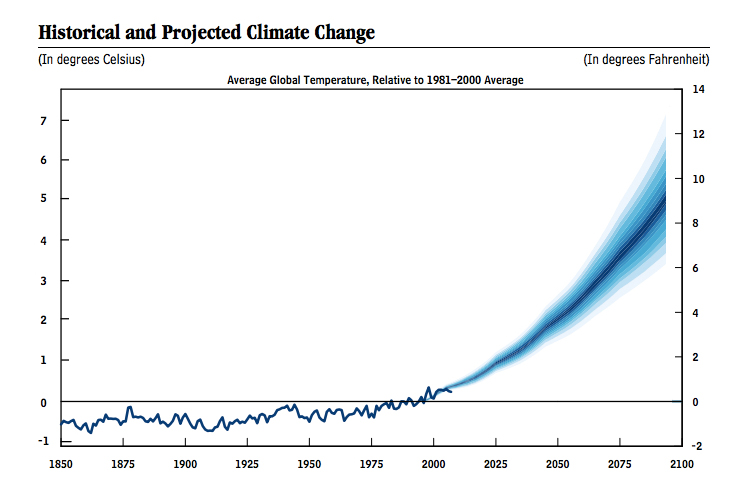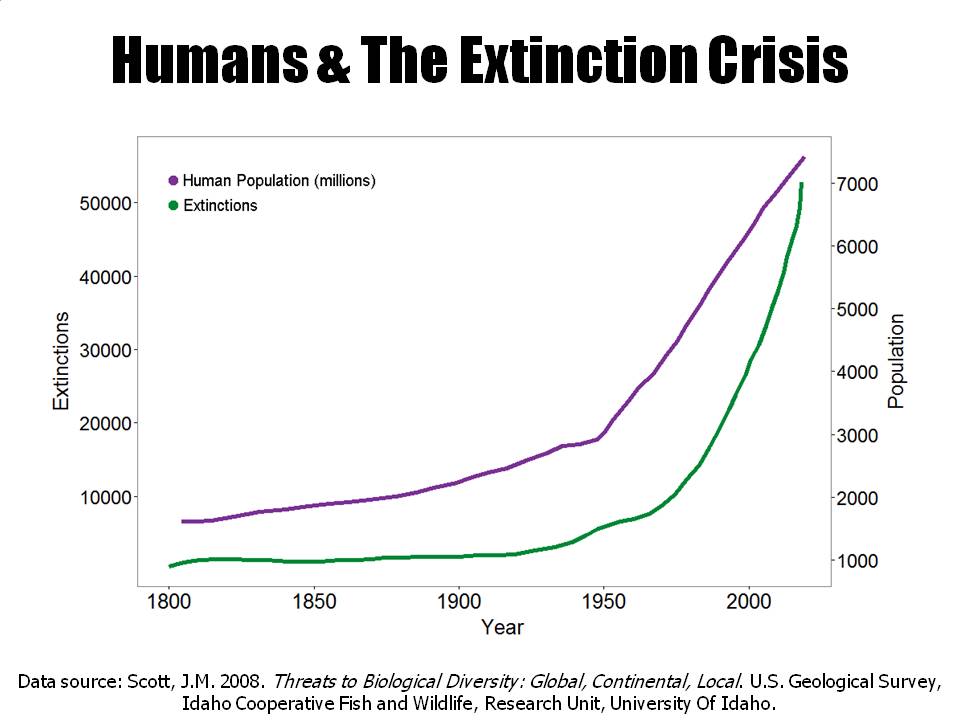Moment of Truth
 By now, most everyone realizes we’re in the thick of a world-wide COVID-19 pandemic and increasing numbers are finally coming to grips with the climate and species extinction crises. The stakes have never been higher than now; we are living in the most important moment in human history. Our hotter and drier world is far more conductive to fires, floods, hurricanes and other forms of what used to be thought of as natural disasters. The pivotal question is whether this spike in the number of infections shown in this chart will serve as a critical inflection point for what are far more serious threats, the climate and species extinction crises.
By now, most everyone realizes we’re in the thick of a world-wide COVID-19 pandemic and increasing numbers are finally coming to grips with the climate and species extinction crises. The stakes have never been higher than now; we are living in the most important moment in human history. Our hotter and drier world is far more conductive to fires, floods, hurricanes and other forms of what used to be thought of as natural disasters. The pivotal question is whether this spike in the number of infections shown in this chart will serve as a critical inflection point for what are far more serious threats, the climate and species extinction crises.
What’s now clear is that there are shared features or attributes between climate breakdown, the species extinction crises and diseases such as COVID-19, bird flu and HIV, entirely caused by animals removed from wilderness for farming, logging and trade in wild species which has brought people into contact with dangerous microbes. Unless the destruction of the natural world is halted, this current “era of pandemics” will become permanent due to the potential risk of an estimated 1.7 million currently “undiscovered” viruses, up to 850,000 of which could infect humans. There is a global effort afoot to preserve 30 percent of land, allowing the natural world and us to persist. E.O. Wilson maintains we need to preserve 50 percent in order to save ourselves. An October, 2020 report from the Intergovernmental Science-Policy Platform on Biodiversity and Ecosystem Services posits the same activities that are causing the climate and species extinction crises are driving pandemic risks – capitalism’s dependence on growth and consumption. With one hundred companies tare he source of 71% of global greenhouse emissions since 1988, the planet is overwhelmed by the “5-Cs”: capitalism, corporations, concentration, consumption and convenience.
Consumption and greenhouse gas emissions by whom is the counterfeit question countries and the public have been quarreling over. Looking more closely, the social crime of consumption, the carbon emissions accompanying it and threatens our survival is dominated by the lifestyles of those earning $34,000 or more a year, the top One Percent of the world’s income earners. Yes, you read that right, world-wide, $34,000 is the cut off point for the top One Percent. If you’re reading this, that likely means you. And me. Another 2020 study in the journal Nature Communications, “’Scientists’ Warning on Affluence,” concludes that the most fundamental cause of environmental destruction is the overconsumption of the super-rich. Excessive consumption is the chief driver of industrial agriculture, stockyard beef, deforestation, fossil fuel use, air travel and other causes of these three crises — the civilization threatening trifecta of climate breakdown, species extinction and viruses like COVID-19.
 It turns out the economic theory that helped create the world’s most prosperous nation has a structural obsession with endless growth in a finite world of natural resources that is destroying basic conditions necessary for the survival of life on Earth. Concentrated corporate capitalism has fostered a global structural inequality where:
It turns out the economic theory that helped create the world’s most prosperous nation has a structural obsession with endless growth in a finite world of natural resources that is destroying basic conditions necessary for the survival of life on Earth. Concentrated corporate capitalism has fostered a global structural inequality where:
- the richest 10 percent of people in the world are responsible for 43 percent of destructive global environmental impacts
- while the poorest 10 percent cause about 5 percent of the loss.
This imbalance is intimately related to the downturn in environmental stability threating the very existence of human societies. The Scientists’ Warning paper concludes: “It is clear that prevailing capitalist, growth-driven economic systems have not only increased affluence since World War II, but have led to enormous increases in inequality, financial instability, resource consumption and environmental pressures on vital earth support systems.” One percent of the world’s farms operate 70 percent of crop fields, ranches and orchards. The top One Percent (the richest 1 in 1,000 Americans, fewer than 200,000 families) holds as much wealth as the bottom 90 percent of Americans (about 110 million households). These few Americans have risen to levels of income and wealth unseen in the short history of this republic’s experiment in democracy.
Consumption is the central problem, significantly reducing it and a sharp uptick in natural-climate solutions are the main solutions to our quandary. The era of internal combustion is over. Consuming less and the elimination of fossil fuels will prevent the worsening of these three crises, but the legacy load of atmospheric carbon dioxide (CO2) must be recaptured and returned underground where it belongs. Most fossil fuels, the principal cause of the greenhouse effect, where in the ground until the Industrial Revolution. Our reliance on coal and oil since then has been almost exclusive. Current CO2 levels will soon be upwards of 415 parts per million (ppm) when 350 ppm is the well-recognized safe level. Absent an abrupt turnabout, by the end of the century, civilization, as we know it, will be over.
 And as the world’s population increases, the balance of life on the planet is plummeting. The ongoing human encroachment into the habitat of wildlife will not only fuel the “era of pandemics,” with the release of other yet unknown viruses, but will maintain the accelerating increase in greenhouse gasses and numbers of species blinking out.
And as the world’s population increases, the balance of life on the planet is plummeting. The ongoing human encroachment into the habitat of wildlife will not only fuel the “era of pandemics,” with the release of other yet unknown viruses, but will maintain the accelerating increase in greenhouse gasses and numbers of species blinking out.
Natural climate solutions are a relatively inexpensive, nature-based way to accomplish the draw-down of excess atmospheric carbon. Two recent papers – Natural Climate Solutions, Proceedings of the National Academy of Sciences and Natural Climate Solutions for the United States, Environmental Studies, maintain that as much as 37 percent of the Paris Climate Accord goals can be attained by a combination of 21 natural-climate solutions. The cure entails living on the planet differently, more responsibly and supporting healthy soil and plant growth. Technologically or naturally, there is no other known way to extract the 65 ppm (415 less 350) legacy load of carbon from the overheated atmosphere to the near unanimous agreed-on 350 ppm. The proposition of natural-climate solutions means humankind must make another major civilization transition. First, we moved from hunter-gatherer way of life to an Agricultural Civilization, next to Industrial Civilization and now we must transform our world into an Environmental Civilization.
Nature’s Mangum Opus is the marvelous process of photosynthesis where plants ingest carbon dioxide (CO2, one carbon atom and two oxygen atoms), and then releases oxygen into the atmosphere for us and other life to breath. Plants consumes about 60 % of the carbon nutrients for themselves and transfers up to 40% of the nourishment to the multiple upon multiple zillions of earthlings living under foot in the subsurface world. No contest, photosynthesis is the most essential natural process for life on our planet. Recall this simple but life-giving system from your sixth-grade science class: photosynthesis allows plants to consume CO2 and emit oxygen for above ground life.
What most of us didn’t learn in elementary school, because scientists didn’t fully understand, is the importance of the little-known subsurface microbial world of soil in the lower right corner of the above diagram. The dirt or soil we live on and from is a vast underground kingdom of microorganisms without which life as we know it would not exist – far richer than we ever imagined. All forms of underground life require carbon and plants provide their foods – sugars, proteins and carbohydrates. This is what’s now known about the extent and importance of the lightless world under foot.
- There are more microorganisms in a cup of healthy soil than the number of all the humans who have ever lived — 113 billion people.
- The dark, underground world is thought to account for up to 95 percent of the planet’s species diversity.
- Healthy soil contains as many as six billion tiny organisms per tablespoon or two hundred billion microbes in a handful of soil.
- Scientists guess that as many as 75,000 species of bacteria could be in a single teaspoon, along with 25,000 species of fungi, 1,000 species of protozoa, and 100 species of tiny worms called nematodes.

One-rock dam. Note the captured sediment above the structure in the upper, down-channel portion of the photograph. Credit: Lucinda Cole
If we can agree that a life of civic virtue is better than the mere existence on the sidelines as part of the life-destroying consumer culture, what can each of us do to help draw the legacy load of carbon from the atmosphere? Beyond elimination of fossil-fuel use, engagement in disruptive protest — peaceful but persistent — and a radical reduction in consumption to arrest greenhouse gas pollution, there is a workable course of action to extract the carbon that lies beyond the imperative of reducing consumption and doing away with non-renewable fuel use.
Aldo Leopold did some of the first habitat restoration in America for the sole purpose — not for crop or timber or profit — of simply restoring the land. For the individual, the way to help further the transition to an ecologically centered world is to do what Leopold, his family and friends did with shovel and axe on his and Estelle’s worn out, abandoned 80-acre Wisconsin sand farm - pursue one of the 21 natural-climate solutions, habitat restoration. Easily constructed erosion-control structures or One-rock dams are undemanding to build and cost nothing. Google it. More than 800 hand-built One-rock dams or grade-control structures have been installed on the Pitchfork Ranch since 2004. See other examples under Habitat Restoration on the navigation bar of pitchforkranchnm.com.
For most landowners or renters, another way to take part in this shift is to plant seedlings or a Climate Garden (akin to the WWII Victory Gardens) or create a backyard sweet spot. The combination of these three crises is far more dangerous than war. Lawns are the single largest agricultural sector in America, and there are organizations like Urban Gardens, Food Not Lawns, Rooftop Gardening, Urban Farming and Edible Gardens that welcome new membership, offering an environmentally constructive way to live with yards. The conversion of backyards and even front lawns to Climate Gardens is a response to the climate crisis that each of us can make. There are a number of other habitat restoration options detailed in the two Natural climate Solution papers mentioned above. All of us can do this, on our own or with our families and neighbors. Whether you initiate a restoration program on you own land or join a volunteer program, these crises require we all get our hands dirty.
Keep in mind too, just as important as natural climate solutions, is to take to the streets, protest and demand what we need by forcing our government to not only commit, but to comply with their pledge and obligation to the Paris Climate Accord.

